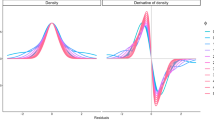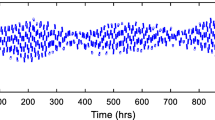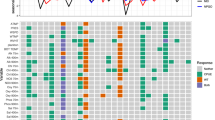Abstract
Time-frequency analysis has become a fundamental component of many scientific inquiries. Due to improvements in technology, the amount of high-frequency signals that are collected for ecological and other scientific processes is increasing at a dramatic rate. In order to facilitate the use of these data in ecological prediction, we introduce a class of nonlinear multivariate time-frequency functional models that can identify important features of each signal as well as the interaction of signals corresponding to the response variable of interest. Our methodology is of independent interest and utilizes stochastic search variable selection to improve model selection and performs model averaging to enhance prediction. We illustrate the effectiveness of our approach through simulation and by application to predicting spawning success of shovelnose sturgeon in the Lower Missouri River.
Similar content being viewed by others
References
Albert, J. H., and Chib, S. (1993), “Bayesian Analysis of Binary and Polychotomous Response Data,” Journal of the American Statistical Association, 88 (422), 669–679.
Ansari-Asl, K., Bellanger, J., Bartolomei, F., Wendling, F., and Senhadji, L. (2005), “Time-Frequency Characterization of Interdependencies in Nonstationary Signals: Application to Epileptic EEG,” IEEE Transactions on Biomedical Engineering, 52 (7), 1218–1226.
Chipman, H. (1996), “Bayesian Variable Selection With Related Predictors,” Canadian Journal of Statistics, 24 (1), 17–36.
Crainiceanu, C. M., Staicu, A., and Di, C. (2009), “Generalized Multilevel Functional Regression,” Journal of the American Statistical Association, 104 (488), 1550–1561.
Cranstoun, S. D., Ombao, H. C., von Sachs, R., Guo, W., and Litt, B. (2002), “Time-Frequency Spectral Estimation of Multichannel EEG Using the Auto-SLEX Method,” IEEE Transactions on Biomedical Engineering, 49 (9), 988–996.
Cressie, N., and Wikle, C. K. (2011), Statistics for Spatio-Temporal Data, New York: Wiley.
DeLonay, A. J., Papoulias, D. M., Wildhaber, M. L., Annis, M., Bryan, J. L., Griffith, S. A., Holan, S. H., and Tillit, D. E. (2007), “Use of Behavioral and Physiological Indicators to Evaluate Scaphirhynchus Sturgeon Spawning Success,” Journal of Applied Ichthyology, 23, 428–435.
Draper, D. (1995), “Assessment and Propagation of Model Uncertainty” (with discussion), Journal of the Royal Statistical Society. Series B. Methodological, 57 (1), 45–97.
Feichtinger, H. G., and Strohmer, T. (1998), Gabor Analysis and Algorithms: Theory and Applications, Basel: Birkhäuser.
Funk, J. L., and Robinson, J. W. (1974), Changes in the Channel of the Lower Missouri River and Effects on Fish and Wildlife, Jefferson City: Missouri Department of Conservation.
Galat, D. L., and Lipkin, R. (2000), “Restoring Ecological Integrity of Great Rivers: Historical Hydrographs Aid in Defining Reference Conditions for the Missouri River,” Hydrobiologia, 422, 29–48.
Gelfand, A. E., and Ghosh, S. K. (1998), “Model Choice: A Minimum Posterior Predictive Loss Approach,” Biometrika, 85 (1), 1–11.
George, E. I. (2000), “The Variable Selection Problem,” Journal of the American Statistical Association, 95 (452), 1304–1308.
George, E. I., and McCulloch, R. E. (1993), “Variable Selection Via Gibbs Sampling,” Journal of the American Statistical Association, 88 (423), 881–889.
— (1997), “Approaches for Bayesian Variable Selection,” Statistica Sinica, 7, 339–374.
Geweke, J. (1992), “Variable Selection and Model Comparison in Regression,” in Bayesian Statistics 4, eds. J. M. Bernardo, J. O. Berger, A. P. Dawid, and A. F. M. Smith, Oxford: Oxford Press, pp. 609–620.
Gröchenig, K. (2001), Foundations of Time-Frequency Analysis, Basel: Birkhäuser.
Hesse, L. W., and Sheets, W. (1993), “The Missouri River Hydrosystem,” Fisheries, 18 (5), 5–14.
Hoeting, J. A., Madigan, D., Rafferty, A. E., and Volinsky, C. T. (1999), “Bayesian Model Averaging: A Tutorial” (with discussion), Statistical Science, 14 (4), 382–417.
Holan, S. H., Davis, G. M., Wildhaber, M. L., DeLonay, A. J., and Papoulias, D. M. (2009), “Hierarchical Bayesian Markov Switching Models With Application to Predicting Spawning Success of Shovelnose Sturgeon,” Journal of the Royal Statistical Society. Series C. Applied Statistics, 58 (1), 47–64.
Holan, S. H., Wikle, C. K., Sullivan-Beckers, L. E., and Cocroft, R. B. (2010), “Modeling Complex Phenotypes: Generalized Linear Models Using Spectrogram Predictors of Animal Communication Signals,” Biometrics, 66 (3), 914–924.
Holan, S. H., Yang, W. H., Matteson, D. S., and Wikle, C. K. (2012), “An approach for identifying and predicting economic recessions in real-time using time-frequency functional models,” Applied Stochastic Models in Business and Industry, 28, 485–499.
Hosmer, D., and Lemeshow, S. (2000), Applied Logistic Regression, New York: Wiley.
James, G. M. (2002), “Generalized Linear Models with Functional Predictors,” Journal of the Royal Statistical Society. Series B. Statistical Methodology, 64 (3), 411–432.
Jolliffe, I. T. (2010), Principal Component Analysis, Berlin: Springer.
Kestin, T. S., Karoly, D. J., Yano, J.-I., and Rayner, N. A. (1998), “Time-Frequency Variability of ENSO and Stochastic Simulations,” Journal of Climate, 11 (9), 2258–2272.
Martinez, J. G., Bohn, K. M., Carroll, R. J., and Morris, J. S. (2013), “A Study of Mexican Free-Tailed Bat Chirp Syllables: Bayesian Functional Mixed Models for Nonstationary Acoustic Time Series,” UT MD Anderson Cancer Center Department of Biostatistics Working Paper Series, Working Paper 79.
Morris, J. S., Baladandayuthapani, V., Herrick, R. C., Sanna, P., and Gutstein, H. B. (2011), “Automated Analysis of Quantitative Image Data Using Isomorphic Functional Mixed Models, With Application to Proteomics Data,” Annals of Applied Statistics, 5 (2A).
Müller, H. G., and Stadtmüller, U. (2005), “Generalized Functional Linear Models,” The Annals of Statistics, 33 (2), 774–805.
O’Hara, R. B., and Sillanpää, M. J. (2009), “A Review of Bayesian Variable Selection Methods: What, How and Which,” Bayesian Analysis, 4 (1), 85–118.
Ombao, H., Raz, J., Von Sachs, R., and Guo, W. (2002), “The SLEX Model of a Non-Stationary Random Process,” Annals of the Institute of Statistical Mathematics, 54 (1), 171–200.
Ombao, H., Von Sachs, R., and Guo, W. (2005), “SLEX Analysis of Multivariate Nonstationary Time Series,” Journal of the American Statistical Association, 100 (470), 519–531.
Oppenheim, A. V., and Schafer, R. W. (2009), Discrete-Time Signal Processing, Prentice Hall Signal Processing.
Qin, L., Guo, W., and Litt, B. (2009), “A Time-Frequency Functional Model for Locally Stationary Time Series Data,” Journal of Computational and Graphical Statistics, 18 (3), 675–693.
Reiss, P. T., and Ogden, R. T. (2010), “Functional Generalized Linear Models With Images as Predictors,” Biometrics, 66 (1), 61–69.
Spiegelhalter, D. J., Best, N. G., Carlin, B. P., and Van Der Linde, A. (2002), “Bayesian Measures of Model Complexity and Fit,” Journal of the Royal Statistical Society. Series B. Statistical Methodology, 64 (4), 583–639.
Stingo, F. C., Vannucci, M., and Downey, G. (2012), “Bayesian Wavelet-Based Curve Classification Via Distribution Analysis With Markov Random Tree Priors,” Statistica Sinica, 22, 465–488.
U.S. Fish and Wildlife Service (2000), Biological Opinion on the Operation of the Missouri River Main Stem Reservoir System, Operation and Maintenance of the Missouri River Bank Stabilization and Navigation Project, and Operation of the Kansas River Reservoir System, Bismarck: US Fish and Wildlife Service.
Vannucci, M., and Stingo, F. C. (2010), “Bayesian Models for Variable Selection That Incorporate Biological Information,” in Bayesian Statistics 9, eds. J. M. Bernardo, M. J. Bayarri, J. O. Berger, A. P. Dawid, D. Heckerman, A. F. M. Smith, and M. West, Oxford: Oxford University Press.
Wahba, G. (1983), “Bayesian Confidence Intervals for the Cross-Validated Smoothing Spline,” Journal of the Royal Statistical Society. Series B. Methodological, 45 (1), 133–150.
Wikle, C. K. (2010), “Low Rank Representations as Models for Spatial Processes,” in Handbook of Spatial Statistics, eds. A. Gelfand, P. Diggle, M. Fuentes, and P. Guttorp, London: Chapman and Hall/CRC, pp. 107–118.
Wikle, C. K., and Cressie, N. (1999), “A Dimension-Reduced Approach to Space-Time Kalman Filtering,” Biometrika, 86 (4), 815.
Wikle, C. K., and Holan, S. H. (2011), “Polynomial Nonlinear Spatio-Temporal Integro-Difference Equation Models,” Journal of Time Series Analysis, 32 (4), 339–350.
Wikle, C. K., and Hooten, M. B. (2010), “A General Science-Based Framework for Spatio-Temporal Dynamical Models,” Test, 19 (3), 417–451.
Wildhaber, M. L., DeLonay, A. J., Papoulias, D. M., Galat, D. L., Jacobson, R. B., Simpkins, D. G., Braaten, P. J., Korschegen, C. E., and Mac, M. J. (2007), “A Conceptual Life-History Model for Pallid and Shovelnose Sturgeon,” Tech. rep., USGS Circular 1315.
— (2011a), “Identifying Structural Elements Needed for Development of a Predictive Life-History Model for Pallid and Shovelnose Sturgeons,” Journal of Applied Ichthyology, 27, 462–469.
Wildhaber, M. L., Holan, C. H., Davis, G. M., Gladish, D. W., DeLonay, A. J., Papoulias, D. M., and Sommerhauser, D. K. (2011b), “Evaluating Spawning Migration Patterns and Predicting Spawning Success of Shovelnose Sturgeon in the Lower Missouri River,” Journal of Applied Ichthyology, 27, 301–308.
Wolfe, P. J., Godsill, S. J., and Ng, W.-J. (2004), “Bayesian Variable Selection and Regularization for Time–Frequency Surface Estimation,” Journal of the Royal Statistical Society. Series B. Statistical Methodology, 66 (3), 575–589.
Yao, F., and Müller, H. G. (2010), “Functional Quadratic Regression,” Biometrika, 97 (1), 49–64.
Author information
Authors and Affiliations
Corresponding author
Rights and permissions
About this article
Cite this article
Yang, WH., Wikle, C.K., Holan, S.H. et al. Ecological Prediction With Nonlinear Multivariate Time-Frequency Functional Data Models. JABES 18, 450–474 (2013). https://doi.org/10.1007/s13253-013-0142-1
Published:
Issue Date:
DOI: https://doi.org/10.1007/s13253-013-0142-1




